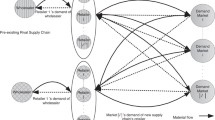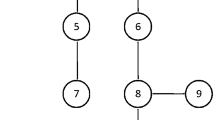Abstract
A chain has to decide the location and design for a single new facility in a region where a set of facilities already exists offering the same type of product. Some of the existing facilities belong to the chain and the others are competitors. Since competition comes from outside the chain, the maximization of the profit is the main objective of the chain’s owner. Customers are supposed to patronize all the facilities, the old and the new, proportionally to the attraction they feel for them. The entrance of the new facility may thus also have a detrimental effect on the market shares of the existing chain-owned facilities, and this cannibalization should be minimized as a secondary objective. This problem is formulated as a biobjective optimization problem, and a variant of the lexicographic method is proposed to generate certain efficient solutions. This requires solving two related optimization problems, both neither convex nor concave, for which a unified interval branch and bound method is developed. Computational experiments on randomly generated problems show the feasibility of the approach, while an application of the model with real data demonstrates its use for economical analysis.
Similar content being viewed by others
References
Achabal D, Gorr WL, Mahajan V (1982) MULTILOC: a multiple store location model. J Retail 58:5–25
Centro Regional de Estadística de Murcia (2003) Anuario estadístico de la Región de Murcia : Dirección General de Economía, Planificación y Estadística, Centro Regional de Estadística de Murcia (2003)
Colomé R, Serra D (2001) Consumer choice and optimal location models: formulations and heuristics. Pap Reg Sci 80:439–464
Current JR, Storbeck JE (1994) A multiobjective approach to design franchise outlet networks. J Oper Res Soc 45:71–81
Drezner T (1994a) Locating a single new facility among existing, unequally attractive facilities. J Reg Sci 34:237–252
Drezner T (1994b) Optimal continuous location of a retail facility, facility attractiveness, and market share: an interactive model. J Retail 70:49–64
Drezner T, Drezner Z (2004) Finding the optimal solution to the Huff based competitive location model. Comput Manage Sci 1:193–208
Drezner T, Drezner Z, Salhi S (2002) Solving the multiple competitive facility location problem. Eur J Oper Res 142:138–151
Drezner Z (ed) (1995) Facility Location: A Survey of Applications and Methods. Springer, Berlin Heidelberg New York
Eiselt HA, Laporte G, Thisse J-F (1993) Competitive location models: a framework and bibliography. Transp Sci 27:44–54
Ehrgott M (2005) Multicriteria Optimization, 2nd edn. Springer, Berlin Heidelberg New York
Fernández J, Fernández P, Pelegrín B (2000) A continuous location model for siting a non-noxious undesirable facility within a geographical region. Eur J Oper Res 121:259–274
Fernández J, Fernández P, Pelegrín B (2002) Estimating actual distances by norm functions: a comparison between the l k,p,θ -norm and the \(l_{b_1,b_2,\theta}\)-norm and a study about the selection of the data set. Comput Oper Res 29:609–623
Fernández J, Pelegrín B (2000) Sensitivity analysis in continuous location models via interval analysis. Stud Locat Anal 14:121–136
Fernández J, Pelegrín B (2001) Using interval analysis for solving planar single-facility location problems: new discarding tests. J Glob Optim 19:61–81
Fernández J, Pelegrín B, Plastria F, Tóth B (2005) Solving a Huff-like competitive location and design model for profit maximization in the plane. Eur J Oper Res DOI: 10.1016/j.ejor.2006.02.005. (to appear)
Fernández J, Pelegrín B, Plastria F, Tóth B (2004) Sensitivity of optimal solutions to a Huff-type competitive location and design problem (Working paper)
Fernández J, Tóth B, Plastria F, Pelegrín B (2006) Reconciling franchisor and franchisee: a planar biobjective competitive location and design model. In: Recent Advances in Optimization. Lectures Notes in Economics and Mathematical Systems vol. 563. Springer, Berlin Heidelberg New York, pp375–398
Fishburn PC (1974) Lexicographic orders, utilities and decision rules: a survey. Manage Sci 20:1442–1471
Friesz TL, Miller T, Tobin RL (1988) Competitive networks facility location models: a survey. Pap Reg Sci Assoc 65:47–57
Ghosh A, Craig CS (1991) FRANSYS: a franchise distribution system location model. J Retail 67:466–495
Hammer R, Hocks M, Kulisch U, Ratz D (1995) C++ Toolbox for Verified Computing. Springer, Berlin Heidelberg New York
Hansen E (1992) Global Optimization Using Interval Analysis. Marcel Dekker, New York
Hansen P, Jaumard B (1995) Lipschitz optimization. In: Handbook of Global Optimization. Kluwer, Dordrecht, The Netherlands, pp407–494
Hansen P, Jaumard B, Tuy H (1995) Global optimization in location. In: Facility Location: A Survey of Applications and Methods. Springer, Berlin Heidelberg New York, pp 43–68
Hodgson MJ (1981) A location-allocation model maximizing consumers’ welfare. Reg Stud 15:493–506
Huff DL (1964) Defining and estimating a trading area. J Mark 28:34–38
Huff DL (1966) A programmed solution for approximating an optimum reail location. Land Econ 42:293–303
Jain AK, Mahajan V (1979) Evaluating the competitive environment in retailing using multiplicative competitive interactive models. In: Sheth J (ed) Research in Marketing. JAI Press, Greenwich, Connecticut, pp 217–235
Kearfott RB (1996) Rigorous Global Search: Continuous Problems. Kluwer, Dordrecht, The Netherlands
Kearfott RB, Nakao MT, Neumaier A, Rump SM, Shary SP, van Hentenryck P (2002) Standardized notation in interval analysis. Reliab Comput. Submitted for publication, available at http://www.mat.univie.ac.at/~neum/software/int/
Kilkenny M, Thisse JF (1999) Economics of location: a selective survey. Comput Oper Res 26:1369–1394
Knüppel O (1994) PROFIL/BIAS—a fast interval library. Comput 53:277–287
Markót MC, Fernández J, Casado LG, Csendes T (2006) New interval methods for constrained global optimization. Math Prog Ser A 106:287–318
Martínez JA, Casado LG, García I, Tóth B, AMIGO: Advanced Multidimensional Interval analysis Global Optimization algorithm. In: Frontiers in Global Optimization. Nonconvex Optimization and its Applications, vol. 74. Kluwer, pp313–326 (2003)
Miettinen KS (1998) Nonlinear multiobjective optimization. Kluwer, Boston, Massachusetts
Miller TC, Friez TL, Tobin RL (1996) Equilibrium Facility Location on Networks. Springer, Berlin Heidelberg New York
Nakanishi M, Cooper LG (1974) Parameter estimate for mutiplicative interactive choice model: least square approach. J Mark Res 11:303–311
Peeters PH, Plastria F (1992) Discretization results for the Huff and Pareto–Huff competitive location models on networks. Top 6:247–260
Plastria F (1992) GBSSS: the generalized big square small square method for planar single-facility location. Eur J Oper Res 62:163–174
Plastria F (2001) Static competitive facility location: an overview of optimisation approaches. Eur J Oper Res 129:461–470
Plastria F (2005) Avoiding cannibalization and/or competitor reaction in planar single facility location. J Oper Res Soc Jpn 48:148–157
Ratschek H, Rokne J (1984) Computer Methods for the Range of Functions. Ellis Horwood, Chichester, UK
Ratschek H, Rokne J (1988) New Computer Methods for Global Optimization. Ellis Horwood, Chichester, UK
Schmalensee R, Thisse JF (1988) Perceptual maps and the optimal location of new products: an integrative essay. Int J Res Mark 5:225–249
Suarez-Vega R, Santos-Peñate DR, Dorta-González P (2004) Discretization and resolution of the (r/X p ) medianoid problem involving quality criteria. Top 12:111–133
Tóth B, Csendes T (2005) Empirical investigation of the convergence speed of inclusion functions. Reliab Comput 11:253–273
Tóth B, Fernández J, Csendes T (2007) Empirical convergence speed of inclusion functions for facility location problems. J Comput Appl Math 199:384–389 DOI:10.1016/j.cam.2005.07.037
Visual GIS Engineering (2003) VisualMap. Basauri 17 (La Florida) 28023 Madrid
Wendell RE, McKelvey RD (1981) New perspectives in competitive location theory. Eur J Oper Res 6:174–182
Author information
Authors and Affiliations
Corresponding author
Additional information
This paper has been supported by the Ministry of Education and Science of Spain under the research project SEJ2005-06273/ECON, in part financed by the European Regional Development Fund (ERDF).
Boglárka Tóth, on leave from the Research Group on Artificial Intelligence of the Hungarian Academy of Sciences and the University of Szeged, H-6720 Szeged, Aradi vértanúk tere 1., Hungary.
Rights and permissions
About this article
Cite this article
Fernández, J., Pelegrín, B., Plastria, F. et al. Planar Location and Design of a New Facility with Inner and Outer Competition: An Interval Lexicographical-like Solution Procedure. Netw Spat Econ 7, 19–44 (2007). https://doi.org/10.1007/s11067-006-9005-4
Published:
Issue Date:
DOI: https://doi.org/10.1007/s11067-006-9005-4




